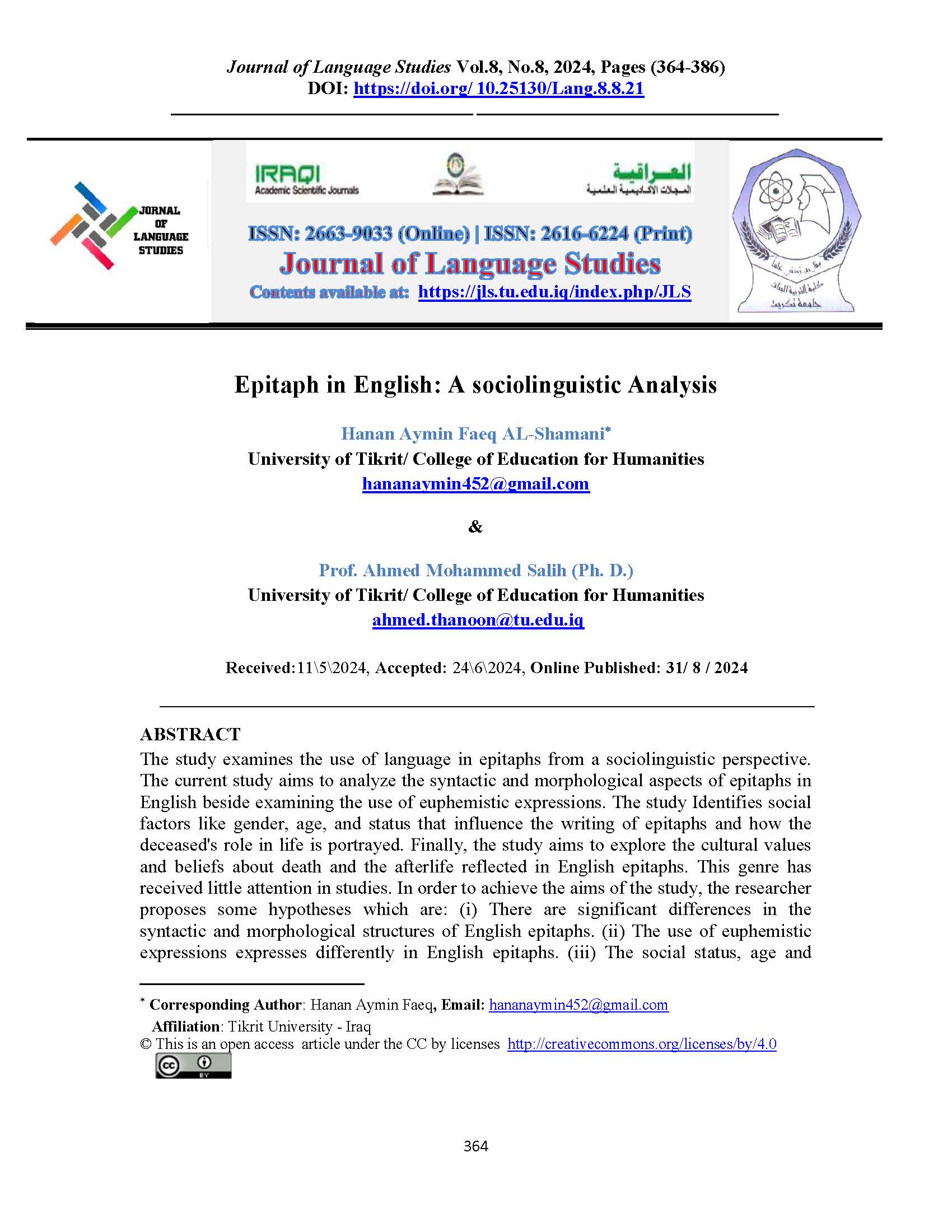Epitaph in English: A sociolinguistic Analysis
DOI:
https://doi.org/10.25130/Lang.8.8.21Keywords:
Epitaph, euphemistic expressions, morpho-syntactic structureAbstract
The study examines the use of language in epitaphs from a sociolinguistic perspective. The current study aims to analyze the syntactic and morphological aspects of epitaphs in English beside examining the use of euphemistic expressions. The study Identifies social factors like gender, age, and status that influence the writing of epitaphs and how the deceased's role in life is portrayed. Finally, the study aims to explore the cultural values and beliefs about death and the afterlife reflected in English epitaphs. This genre has received little attention in studies. In order to achieve the aims of the study, the researcher proposes some hypotheses which are: (i) There are significant differences in the syntactic and morphological structures of English epitaphs. (ii) The use of euphemistic expressions expresses differently in English epitaphs. (iii) The social status, age and gender of the deceased are reflected in English epitaphs. (iv) Culture and religion influence the content of English epitaphs. The study analyzes 13 English epitaphs using qualitative research design. The key findings indicate differences in morpho-syntactic structure, with no gender markers used in English epitaphs . implicit euphemisms is found in English epitaphs. Social factors like gender, age, and status are more frequently reflected in English epitaph. There are differences in the linguistic cues used for male versus female epitaphs. The study provides insights into how language reflects cultural and societal norms in funeral rituals.
References
Allan, K., & Burridge, K. (2006). Forbidden Words: Taboo and the Censoring of Language. Cambridge University Press.
Aziz, Y. Y. (1989). A Contrastive Grammar of English and Arabic. University of Mosul Press.
Bernhardt-Kabisch, E. (1967). Epitaphs. The Journal of American Folklore, 80(318), 113-124.
Braman, S. (2004). Biotechnology and Communication: The Meta-Technologies of Information. (n.p.): Taylor & Francis.
Brunton, A. (2020). Epitaphs and the dead in early modern English manuscripts.( PhD. Thesis). ARU, Faculty Of Arts, Humanities and Social Sciences, Anglia, United Kingdom.
Cohen, H. (1999). "Disrupted Mourning: The Deconstruction of Patriarchal Elegy in Thelwall's Epitaph on Lord Nelson". Wordsworth Circle, 30(3)
Cooley, A. (2012). The Cambridge Manual of Latin Epigraphy. United Kingdom: Cambridge University Press.
Davies, D. J. (2002). Death, Ritual and Belief: The Rhetoric of Funerary Rites (2nd ed.). Continuum.
García,F., Hernández, L., Cervel , M. (2013).Metaphor and Metonymy Revisited Beyond the Contemporary Theory of Metaphor: Recent Developments and Applications. Netherlands: John Benjamins Publishing Company.
Holmes, J. (2013). An Introduction to Sociolinguistics (4th ed.). Routledge.
Johanson, P. (2010). Early British Poetry, "words that Burn". United States: Enslow Publishers.
Lakoff, G., & Turner, M. (1989). More than Cool Reason: A Field Guide to Poetic Metaphor. Chicago: University of Chicago Press.
Leech, G. (1981). Semantics: The Study of Meaning (2nd ed.). Penguin Books.
Pearson, M. P. (2003). The Archaeology of Death and Burial. Sutton Publishing.
Pettigrew, T. J. (1857). Chronicles of the Tombs: A Select Collection of Epitaphs, Preceded by an Essay on Epitaphs and Other Monumental Inscriptions, with Incidental Observations on Sepulchral Antiquities. United Kingdom: H.G. Bohn.
Quirk, R., Greenbaum, S., Leech, G., & Svartvik, J. (1985). A Comprehensive Grammar of the English Language. London: Longman.
Scodel J. (1991). The English poetic epitaph : commemoration and conflict from Jonson to wordsworth. Cornell University Press.
Segal, A. (2010). Life After Death: A History of the Afterlife in Western Religion. United Kingdom: Crown Publishing Group.
Sharma, A. (1998). The Sterling Dictionary Of Literary Terms. India :Sterling Publishers Private Limited.
Smith, J. (2015). The Role of Epitaphs in Remembering the Deceased. Journal of Death Studies, 25(2), 123-145.
Smith, J. (2020). Christian Epitaphs: Reflections on Faith and Eternity. Journal of Religious Studies, 25(2).
Thorne, J. O. (2014). "Fine Words: A Study of Epitaphs and Eulogia in Greek Literature". Oxford University Press.
Vidal, R. & Blanco, M.(2014). The Power of Death: Contemporary Reflections on Death in Western Society. Germany: Berghahn Books.
Williams, H. (2008). "Epitaphs: To Die For". Orion Publishing Group.

